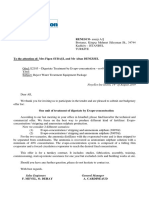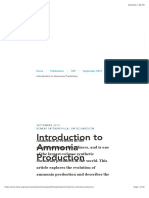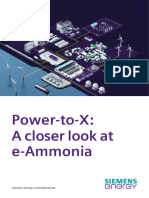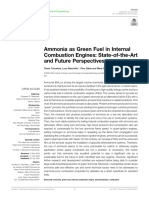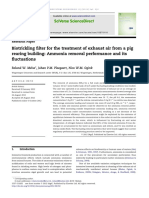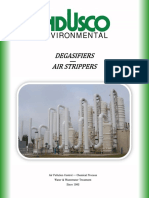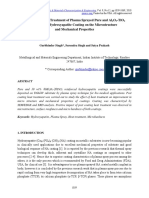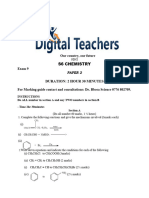Stripping Ammonia in Anaerobic Digesters: Robert Eden Discusses Thermal Stripping in Hong Kong
Stripping Ammonia in Anaerobic Digesters: Robert Eden Discusses Thermal Stripping in Hong Kong
Uploaded by
Umut Sinan ÇetinbaşCopyright:
Available Formats
Stripping Ammonia in Anaerobic Digesters: Robert Eden Discusses Thermal Stripping in Hong Kong
Stripping Ammonia in Anaerobic Digesters: Robert Eden Discusses Thermal Stripping in Hong Kong
Uploaded by
Umut Sinan ÇetinbaşOriginal Title
Copyright
Available Formats
Share this document
Did you find this document useful?
Is this content inappropriate?
Copyright:
Available Formats
Stripping Ammonia in Anaerobic Digesters: Robert Eden Discusses Thermal Stripping in Hong Kong
Stripping Ammonia in Anaerobic Digesters: Robert Eden Discusses Thermal Stripping in Hong Kong
Uploaded by
Umut Sinan ÇetinbaşCopyright:
Available Formats
feature wastewater treatment
hong kong: WHILE The removal of ammonia from wastewater is a perennial challenge
for wastewater engineers, the country has incubated world-leading technology
Stripping Ammonia
in Anaerobic Digesters
Robert Eden discusses thermal stripping in Hong Kong
G
IVEN its high population density, coupled with the cleaner if in doubt), so it should not be unexpected that many
demanding environmental standards enforced by bacteria are similarly distressed.
the Environmental Protection Department, it is not
surprising that Hong Kong served as the incubator for our
process to remove ammonia from wastewater. What has The problem
resulted is a novel thermal ammonia stripping technology, Although ammonia is a source of nutrient for bacterial growth
which has low operating costs, high standards, and a small during AD, its inhibitory effect at high concentrations can be
footprint. lethally toxic to bacteria that have thrived on its presence at
Since 1997, the technology has been applied to both leachate lower concentrations.
from landfill sites, as well as the side-stream flows from an According to the National Non-Food Crops Centre (NNFCC),
anaerobic digester (AD). While highly focussed on the needs there are now 486 operational AD plants in the UK, with a
of Hong Kong, the technology is gaining momentum in other further 343 under development. AD is established as a commer-
countries, where environmental compliance is a serious issue cially viable form of renewable energy generation. The AD
to address. It is also moving from leachate cleanup applications process produces biogas, consisting of methane and carbon
into AD. dioxide, as well as various trace gases. Biogas can be used
To many engineers not involved with AD, the problems directly as fuel, in spark-ignition gas engines or upgraded to
caused by ammonia may come as a surprise. It is well known natural gas-quality biomethane. The nutrient-rich digestate
that ammonia is toxic to fish and humans (sniff that floor produced can be used as fertiliser.
JULY/AUGUST 2019 | The Chemical Engineer | page 45
ammoniav2 DG.indd 45 09/07/2019 14:17
feature wastewater treatment
With an increasing global interest in producing biogas from food process efficiency considerations, there are also several tech-
waste, the difficulties encountered with ammonia poisoning of nology variants that may be deployed to control ammonia. It is
AD facilities are now becoming more frequently encountered. not so much a lack of choice, which is the issue here, but rather
Protein-rich substrates are valuable for methane produc- an understanding of the issues that may be encountered with
tion. They are of great interest in commercial biogas each option.
production. Unfortunately, high loadings with such materials
often correlate with process instability, due to the presence of Biological nitrification
ammonia, released from the degradation of amino acids during Biological nitrification is widely employed, well understood,
acidogenesis. and generally reliable. Biological nitrification produces varying
There are two forms of ammonia encountered in wastewa- amounts of sludge and requires both oxygen and carbon to
ter. The ionic form (NH4+) and the gaseous form (NH3). They are perform effectively. Large holding volumes are required.
related by the chemical formula: Significant air (oxygen) and carbon-source additions are also
required. The process may also produce nitrous oxide (N2O), a
NH3 + H+ ↔ NH4+ potent greenhouse gas.
Both forms can, directly and indirectly, cause inhibition in an Anaerobic ammonium oxidation (Anammox)
AD system, although NH3 is generally recognised to be the main In 1995 researchers discovered that Anammox, a previously
inhibitor. The balance of this equation is a function of pH and unknown bacterium, was converting ammonia directly into N2
temperature. Low pH and low temperature push the balance in a fluidised bed reactor. The process that was subsequently
towards NH4+. developed does not require carbon and produces less sludge.
Figures vary, but as ammonium ion concentrations increase Anammox bacteria are specialised and slow growing, which
in an anaerobic digester, typically above 1,000 mg/L, perfor- in turn leads to increased operational risk. Startup can be
mance, in terms of biogas production, drops off. Anaerobic measured in months.
digestion is fully inhibited at around 5,000 mg/L. It is, therefore,
an essential requirement to manage ammonia concentrations, Breakpoint chlorination
a requirement for which there exists a wide range of options. Chlorine is added to wastewater until all free organic
In the past, the most commonly-employed methods have compounds and ammonia are removed. A ratio of approxi-
been to lower the pH, to decrease the free ammonia concen- mately 8:1, chlorine to ammonia is required to convert all the
tration, or to dilute the digester contents with water. It is also ammonia into chloramines. Whilst this is a possible option for
possible to add lignocellulosic biomass, with a high C:N ratio, to discharge flows, it is not suitable for recycle flows. It requires
increase the C:N ratio of the substrate in the digester. potentially large additional quantities of chlorine where
Where such approaches are not possible, or not desirable for organic content is high.
Figure 1: options for ammonia removal in anaerobic digestion BIOGAS
AMMONIA REMOVAL
OPTION 1
AMMONIA REMOVAL
OPTION 3 BLOWER
ANAEROBIC DIGESTER
HYDROLYSIS- AMMONIA REMOVAL
FERMENTATION STAGE OPTION 4
AMMONIA REMOVAL
OPTION 2
JULY/AUGUST 2019 | The Chemical Engineer | page 46
ammoniav2 DG.indd 46 09/07/2019 14:17
feature wastewater treatment
Zeolite ion exchange This results in issues similar to those of membrane contac-
Ammonium ions are swapped with cations within zeolite, tors with the on-site management of chemicals. A substantial
removing virtually all ammonia. The zeolite requires regular airflow is necessary to achieve stripping by this means, usually
regeneration, making application specific to small-scale in the range of 3,000:1, air to wastewater. It is also difficult
situations, such as aquaculture and swimming pools. to achieve better than 80% removal. Where chemicals are
available, pH-driven ammonia stripping provides a reliable
Membrane ion exchange physicochemical route for ammonia removal.
With this technology, ammonia passes through a membrane
into an ionic fluid, driven using electrical power. Ammonia Thermally-driven air stripping
may be recovered from the fluid or converted to nitrogen This requires significant additions of heat, which leads to
gas. The advantages here are the possibility of compact and high operational costs where waste heat is not available. Can
high-performance ammonia removal. The electrical load may achieve 98.5% removal. This technology does not usually
be an issue for some operators. Removing 5 t/d of ammonia require chemical additions.
requires approximately 2 MWe. Within a typical AD facility, there are four locations where
reduction or removal of ammonia may be possible (see Figure 1).
Membrane contactors
Ammonia diffuses through a hydrophobic membrane into • before digestion at the hydrolysis-fermentation stage;
sulfuric acid under osmotic pressure. The wastewater pH • during the digestion in a recycle flow;
needs to be increased to around 10, leading to notable chemical • during digestion within the main digester vessel; and
consumption. In many situations, the pH subsequently needs • post digestion, prior to discharge.
to be reduced by the addition of acid. However, as above, this
provides a compact solution where the management of the Research into the feasibility of removing ammonia during or
necessary chemicals can be accommodated. after the hydrolysis-fermentation stage has resulted in limited
success. The practical options are either within the digester
itself, in a recycle flow or from the discharge.
pH-driven air stripping Stripping ammonia within the digester vessel leaves
This type of air stripper requires pH adjustment to over pH 10. limited scope for process control. Work has been completed by
several researchers using biogas as a stripping medium. With
low-strength ammonia, this may be an option to consider.
The main opportunities for ammonia control in large-scale
Figure 2: Thermal Ammonia Stripper process flow diagram
commercial facilities are, therefore, in recycle and discharge
flows. The former impacts the AD process and leads to improved
HEAT performance. The latter is a matter of discharge compliance.
Thermal stripping in Hong Kong
The systems we have developed in Hong Kong are primarily for
discharge flows. Leachate, or in one case digester effluent, is
heated to the system operating temperature and passed down
EXHAUST through the stripper column, counter-current to a pre-heated
GAS airflow. The design ensures that the air collects up to 98.5% of
the ammonia gas into the air. The air is then passed directly
to a thermal oxidiser where it is combusted, destroying the
ammonia and releasing nitrogen, carbon dioxide and water to
WASTEWATER the atmosphere (see Figure 2).
When thermal air stripping was chosen in 1997 as the
BIOGAS core nitrogen removal process for the West New Territo-
AMBIENT
AIR ries (WENT) landfill site in Hong Kong, currently operated
AIR by Suez, thermal efficiency was not a performance criterion.
STRIPPER
With a design flow rate of 1,800 m3/day, recently upgraded to
THERMAL
OXIDISER 3,350 m3/day, as much landfill gas as necessary was availa-
ble for use. The first design duty for this first plant was for
DISCHARGE
an influent of 6,700 mg ammonia per litre of wastewater, to
be reduced to a discharge of 100 mg/L. The WENT facility
JULY/AUGUST 2019 | The Chemical Engineer | page 47
ammoniav2 DG.indd 47 09/07/2019 14:17
feature wastewater treatment
now removes 14.5 t/d of ammonium ion. Subsequently, similar ammoniated wastewater;
processes have been installed on six additional sites around • no costs are incurred for chemical additions;
Hong Kong. • greenhouse gas production is mitigated by avoiding
Since the commissioning of the first plant, thermal effi- nitrous oxide formation (N2O);
ciency has gradually moved up the list of performance priorities • compared to biological processes, relatively rapid
to a point where it is now a tightly measured variable. Landfill startup can be achieved (1 or 2 hours);
gas in Hong Kong was once seen to be more of a nuisance than • there is no risk of biology failure;
an opportunity. Through improved energy recovery, process • substantial savings may be available from avoidance of
optimisation, and targeted reduction of the necessary airflow carbon-source costs;
rate, the thermal power requirement has been reduced to 20% • there is no sludge formation; and
of that of the first facilities. Options to utilise waste-heat • the system is relatively easy to operate compared to
sources have also been developed. biological processes.
The use of this technology with AD has also been under-
taken in Hong Kong. The application environment is different Where waste heat is available in the form of steam or heat
from that encountered with a typical leachate treatment plant, (from an engine exhaust, for example) there will be, subse-
but the basic principles remain the same. Commissioning in an quent to ammonia stripping from wastewater, a requirement
AD setting is challenging. Unlike a landfill, an AD facility is a to remove ammonia gas from the stripping air. This can be
more tightly-controlled process environment. done either by acid scrubbing, ammonia capture, or a cata-
There are several benefits attributable to thermal stripping lytic conversion. Using biogas or syngas as a source of heat
which indicate situations of optimum deployment: is, therefore, preferred. Here, employing thermal oxidation,
ammonia removed from wastewater can be converted directly
• high removal rates may be achieved in a relatively small into nitrogen and water.
footprint; More recently, in conjunction with staff from the University of
• the process is particularly suited to high-strength Warwick Department of Engineering, Organics has developed a
figure 3: WENT Ammonia Stripping
Plant, rated at 3,250 m3/day
JULY/AUGUST 2019 | The Chemical Engineer | page 48
ammoniav2 DG.indd 48 09/07/2019 14:17
feature wastewater treatment
Figure 4: ammonia recovery Process flow diagram
EXHAUST AIR COLD WATER
CONDENSER
COOLING
AMMONIA
ABSORBER RECTIFIER PRODUCT
AMMONIATED
AIR
GENERATOR
HEAT RECOVERY
PUMP
process which facilitates recovery of either ammonium hydrox- of disposal. Ammonia may also be used in engines and turbines,
ide or anhydrous ammonia. This approach further develops two with ammonia as a fuel. During World War II ammonia was
key process themes: employing waste heat, and avoiding the used to power buses in Belgium. And more recently, Hideaki
use of chemicals. Ammonia-water systems are well understood Kobayashi, professor at the Institute of Fluid Science at Tohoku
and widely applied in refrigeration and adsorption cooling. The University in Sendai, Japan, developed the world’s first technol-
process flow diagram (PFD) for a system recovering ammonia ogy for direct combustion of ammonia in a gas turbine (https://
is provided in Figure 4. Clean, cold water is used to remove bit.ly/2JsK2LC). A high-octane rating of 120 and low flame
ammonia from stripping air. The water is then heated to concen- temperature permits the use of high compression ratios without
trate the ammonia gas as ammonium hydroxide. Additional the penalty of high NOx production. Since ammonia contains no
concentration and separation makes possible the formation of carbon, its combustion cannot produce carbon dioxide, carbon
anhydrous ammonia. monoxide, hydrocarbons, or soot.
Ammonia is joining the growing list of substances that need
to be prevented from polluting the environment and, where
Ammonia is joining the growing list of practical, can be recycled. It is expected that the demand for
substances which need to be prevented compact, low operational cost, ammonia removal technologies
from polluting the environment and, will increase.
where practical, can be recycled Sectors of growth are where large flows with elevated
ammonia concentrations are encountered, such as with landfills
The production of anhydrous ammonia leads to the question taking increased protein loadings, anaerobic digestors taking
of what to do with it. There exist many options, from simple food waste and industrial processes discharging ammoniated
combustion on-site to commercial use. Ammonia is used in a wastewaters – using waste heat to meet these objectives assists
wide range of applications, from pharmaceuticals and agricul- with ensuring a long-term sustainable solution to the challenge
ture to industrial cleaning and explosives. of ammonia pollution.
The energy content of liquid ammonia is 11.5 MJ/L, or approx-
imately 30% that of diesel. Ammonia may be used in fuel cells,
which offers the potential for a local, revenue-generating means Robert Eden is Managing Director, Organics Group
JULY/AUGUST 2019 | The Chemical Engineer | page 49
ammoniav2 DG.indd 49 09/07/2019 14:17
You might also like
- Chemistry PAG 6.3Document4 pagesChemistry PAG 6.3jessys15ukNo ratings yet
- E2185 - Offer RENESCO - Rev0Document39 pagesE2185 - Offer RENESCO - Rev0Umut Sinan ÇetinbaşNo ratings yet
- Contact-Molded "Fiberglass" (Glass-Fiber-Reinforced Thermosetting Resin) Corrosion Resistant Pipe and FittingsDocument7 pagesContact-Molded "Fiberglass" (Glass-Fiber-Reinforced Thermosetting Resin) Corrosion Resistant Pipe and FittingsUmut Sinan ÇetinbaşNo ratings yet
- Control of Evaporator in The Production of UreaDocument15 pagesControl of Evaporator in The Production of Ureatariq fareedNo ratings yet
- 024 EdenDocument9 pages024 EdenGramlotBlacksmithNo ratings yet
- Desalination and Water Treatment: Nguyen Thi My Hanh, Nguyen Hong Van, Pham Thi Minh TrangDocument6 pagesDesalination and Water Treatment: Nguyen Thi My Hanh, Nguyen Hong Van, Pham Thi Minh TrangjuanNo ratings yet
- Methods For Removing Ammonical NitrogenDocument13 pagesMethods For Removing Ammonical Nitrogenshanku_bietNo ratings yet
- Kinidi2018 PDFDocument15 pagesKinidi2018 PDFArash AbbasiNo ratings yet
- Methods of Ammonia Removal in Anaerobic Digestion: A Review: Niclas Krakat, Burak Demirel, Reshma Anjum and Donna DietzDocument14 pagesMethods of Ammonia Removal in Anaerobic Digestion: A Review: Niclas Krakat, Burak Demirel, Reshma Anjum and Donna Dietzengr_afsoomro3147No ratings yet
- LI Et Al 2008 Recent Patents On Anammox ProcessDocument6 pagesLI Et Al 2008 Recent Patents On Anammox Processsafira143No ratings yet
- Dare Stan I 2017Document33 pagesDare Stan I 2017leticiabalvesNo ratings yet
- Anaerobic Ammonium Oxidation Anammox Process For NDocument11 pagesAnaerobic Ammonium Oxidation Anammox Process For NSanathKondaveetiNo ratings yet
- Overview of Nutrients Recovery and Ammonia Stripping ProcessDocument34 pagesOverview of Nutrients Recovery and Ammonia Stripping ProcessTVCNo ratings yet
- MC+BMED For Gaseous Nitrogen ProductionDocument11 pagesMC+BMED For Gaseous Nitrogen ProductionSafa alkhalilNo ratings yet
- Engineers Guide: The Major Features of These Processes Are Described BelowDocument2 pagesEngineers Guide: The Major Features of These Processes Are Described BelowzeeshanNo ratings yet
- Ammonia Removal During Leach-Bed Acidification Leads To Optimized Organic Acid Production From Chicken ManureDocument10 pagesAmmonia Removal During Leach-Bed Acidification Leads To Optimized Organic Acid Production From Chicken ManureAndreNo ratings yet
- Anaerobic MBR Potentials VisuDocument10 pagesAnaerobic MBR Potentials VisuAhmad HashimNo ratings yet
- Ammonia Removalfromaqueoussolutionsusinghollow FiberDocument8 pagesAmmonia Removalfromaqueoussolutionsusinghollow FiberSilvia Rahmi EkasariNo ratings yet
- Ammonia PDFDocument49 pagesAmmonia PDFmfruge7No ratings yet
- Decarbonization in Ammonia Production, New Technological Methods in Industrial Scale Ammonia Production and Critical EvaluationsDocument7 pagesDecarbonization in Ammonia Production, New Technological Methods in Industrial Scale Ammonia Production and Critical EvaluationsAnanthakishnanNo ratings yet
- A Perspective On The Use of Ammonia As A Clean FuelDocument8 pagesA Perspective On The Use of Ammonia As A Clean Fuel백종엽No ratings yet
- Effects of Fulvic Acid On The Denitrification Performance of CompletelyDocument12 pagesEffects of Fulvic Acid On The Denitrification Performance of CompletelyAnais Danhae Figueroa GarciaNo ratings yet
- Ammonia ProductionDocument7 pagesAmmonia ProductionPanchdev Kumar0% (1)
- Removal of Ammonia by OzoneDocument9 pagesRemoval of Ammonia by OzoneMohamed AbdelhadyNo ratings yet
- Pharmaceutical Waste-Water: Parth Naik ICT, MumbaiDocument48 pagesPharmaceutical Waste-Water: Parth Naik ICT, MumbaiShraddha MalveNo ratings yet
- Appl. Environ. Microbiol.-2013-Hu-2807-12Document6 pagesAppl. Environ. Microbiol.-2013-Hu-2807-12Bijay ThapaNo ratings yet
- Van Kessel 2018Document6 pagesVan Kessel 2018Juan Francisco RoaNo ratings yet
- Separations 09 00348Document11 pagesSeparations 09 00348Mi doremiNo ratings yet
- Journal of The Taiwan Institute of Chemical EngineersDocument1 pageJournal of The Taiwan Institute of Chemical EngineersSaeed DehestaniatharNo ratings yet
- Ammonia Removalfrom WastewaterDocument8 pagesAmmonia Removalfrom WastewaterSigiNo ratings yet
- De Ammon If IcationDocument35 pagesDe Ammon If IcationChillie HuNo ratings yet
- Ammonia Nitrogen Removal by Single StageDocument8 pagesAmmonia Nitrogen Removal by Single StagePhan Thi KIm ThuyNo ratings yet
- Ammonia MaterialDocument153 pagesAmmonia MaterialMeghaNo ratings yet
- Ammonia Synthesis CatalystsDocument16 pagesAmmonia Synthesis CatalystsSaqib Ali0% (1)
- Sahu 2008Document8 pagesSahu 2008tamil vaananNo ratings yet
- Recovery of Ammonia From Central Waste WaterDocument14 pagesRecovery of Ammonia From Central Waste Watercormando1992No ratings yet
- Process Simulation of High Pressure Urea Production From Carbon Dioxide and AmmoniaDocument6 pagesProcess Simulation of High Pressure Urea Production From Carbon Dioxide and AmmoniaDaniel Cañon PinedaNo ratings yet
- Ammonia As Renewable SourceDocument39 pagesAmmonia As Renewable SourceMHK ZarkNo ratings yet
- Hanies Ambarsari, Iman Syah, Rudi Nugroho, Brian Saputra Manurung, Fuzi SuciatiDocument8 pagesHanies Ambarsari, Iman Syah, Rudi Nugroho, Brian Saputra Manurung, Fuzi SuciatiArifinNo ratings yet
- Comparative Life Cycle Assessment of Various Ammonia Production MethodDocument17 pagesComparative Life Cycle Assessment of Various Ammonia Production MethodDung Phan Thị ThùyNo ratings yet
- Mahdi 1Document11 pagesMahdi 1nmahajanNo ratings yet
- Kuntia 2012Document10 pagesKuntia 2012maher mzoughiNo ratings yet
- 10.1007@s42452 019 0514 4Document8 pages10.1007@s42452 019 0514 4sinaavajiNo ratings yet
- Chemical Technology Production of Ammonia: Dr. Abhi Mukherjee Department of Chemical Engineering Contai PolytechnicDocument3 pagesChemical Technology Production of Ammonia: Dr. Abhi Mukherjee Department of Chemical Engineering Contai PolytechnicSk jahidul IslamNo ratings yet
- 06 Whitepaper EammoniaDocument16 pages06 Whitepaper Eammoniady16951No ratings yet
- Water and Green Ammonia Recovery From Anaerobic Digestion Effluent by Two-Stage Membrane DistillationDocument11 pagesWater and Green Ammonia Recovery From Anaerobic Digestion Effluent by Two-Stage Membrane DistillationlixiaoluhjNo ratings yet
- Ag Report UreaDocument40 pagesAg Report UreaVakul AgarwalNo ratings yet
- Ammonia Recovery From Anaerobic Digestate Using EAS+EDDocument9 pagesAmmonia Recovery From Anaerobic Digestate Using EAS+EDSafa alkhalilNo ratings yet
- fmech-08-944201Document16 pagesfmech-08-944201nimamo.azadNo ratings yet
- 4 - Pilot Demonstration of Nitrogen Removal From Municipal Wastewater by Vacuum Membrane DistillationDocument9 pages4 - Pilot Demonstration of Nitrogen Removal From Municipal Wastewater by Vacuum Membrane DistillationlixiaoluhjNo ratings yet
- Anammox - A Novel Microbial Process For Ammonium Removal: N. Shivaraman and Geetha ShivaramanDocument2 pagesAnammox - A Novel Microbial Process For Ammonium Removal: N. Shivaraman and Geetha ShivaramanNiladri MondalNo ratings yet
- 2019 Guo2019Document25 pages2019 Guo2019Hassan ChamakhNo ratings yet
- Optimization of Pyrolysis Process To Produce Biochar From Poultry WasteDocument9 pagesOptimization of Pyrolysis Process To Produce Biochar From Poultry WasteInternational Journal of Innovative Science and Research TechnologyNo ratings yet
- Buy Ebook Ammonia Volatilization Mitigation in Crop Farming: A Review of Fertilizer Amendment Technologies and Mechanisms Tianling Li Cheap PriceDocument49 pagesBuy Ebook Ammonia Volatilization Mitigation in Crop Farming: A Review of Fertilizer Amendment Technologies and Mechanisms Tianling Li Cheap PriceserveovaresNo ratings yet
- Journal of Hazardous Materials: Ammonia Stripping For Enhanced Biomethanization of Piggery WastewaterDocument7 pagesJournal of Hazardous Materials: Ammonia Stripping For Enhanced Biomethanization of Piggery WastewaterArash AbbasiNo ratings yet
- AmmoniaDocument16 pagesAmmoniaTinkeNo ratings yet
- 1 s2.0 S138589472030053X MainDocument10 pages1 s2.0 S138589472030053X MainSiddharth SinghNo ratings yet
- Megammonia - The Mega-Ammonia Process For The New Century: DR William L E Davey Ceng, Micheme, DR Thomas WurzelDocument9 pagesMegammonia - The Mega-Ammonia Process For The New Century: DR William L E Davey Ceng, Micheme, DR Thomas Wurzelvaratharajan g rNo ratings yet
- Control of Evaporator in The Production of UreaDocument15 pagesControl of Evaporator in The Production of Ureatariq fareedNo ratings yet
- 1 s2.0 S0956053X11005861 MainDocument9 pages1 s2.0 S0956053X11005861 MainSuleman AhmadNo ratings yet
- Anammox: Sustainable Nitrogen RemovalDocument4 pagesAnammox: Sustainable Nitrogen RemovalLuqmanNo ratings yet
- 21 Melse2012Document11 pages21 Melse2012Sebastian Erick Amaro BelmarNo ratings yet
- Ion Exchange Resins and Adsorbents in Chemical Processing: Second EditionFrom EverandIon Exchange Resins and Adsorbents in Chemical Processing: Second EditionRating: 5 out of 5 stars5/5 (1)
- Lithium Bromide Absorption Chiller For Waste Heat Recovery - GMS InterneerDocument9 pagesLithium Bromide Absorption Chiller For Waste Heat Recovery - GMS InterneerUmut Sinan Çetinbaş100% (1)
- OYS Rigging Service Programme 2019 1.0 - New Contact DetailsDocument11 pagesOYS Rigging Service Programme 2019 1.0 - New Contact DetailsUmut Sinan ÇetinbaşNo ratings yet
- Indusco Degasifier BrochureDocument4 pagesIndusco Degasifier BrochureUmut Sinan ÇetinbaşNo ratings yet
- Byosis General PresentationDocument24 pagesByosis General PresentationUmut Sinan ÇetinbaşNo ratings yet
- Li BR 5035 MSDSDocument1 pageLi BR 5035 MSDSUmut Sinan ÇetinbaşNo ratings yet
- Iso 14692 2 2002 en FRDocument11 pagesIso 14692 2 2002 en FRUmut Sinan ÇetinbaşNo ratings yet
- Air-Cooled Lithium Bromide Absorption Chillers R1Document49 pagesAir-Cooled Lithium Bromide Absorption Chillers R1Umut Sinan ÇetinbaşNo ratings yet
- Experimental Study On The Performance of A Solar-Biomass Hybrid Air-Conditioning S...Document8 pagesExperimental Study On The Performance of A Solar-Biomass Hybrid Air-Conditioning S...Umut Sinan ÇetinbaşNo ratings yet
- E1309Document15 pagesE1309Umut Sinan ÇetinbaşNo ratings yet
- LG Absorption Chillers Have Always Been Korea's No.1 AeroVenticDocument2 pagesLG Absorption Chillers Have Always Been Korea's No.1 AeroVenticUmut Sinan ÇetinbaşNo ratings yet
- Water Fired Absorption Chillers WFC SeriesDocument16 pagesWater Fired Absorption Chillers WFC SeriesUmut Sinan ÇetinbaşNo ratings yet
- D6341Document4 pagesD6341Umut Sinan ÇetinbaşNo ratings yet
- Machine Made Flanges D-4024Document6 pagesMachine Made Flanges D-4024Umut Sinan ÇetinbaşNo ratings yet
- Pultruzyon D3914Document6 pagesPultruzyon D3914Umut Sinan ÇetinbaşNo ratings yet
- Determining Chemical Resistance of Thermosetting Resins Used in Glass-Fiber-Reinforced Structures Intended For Liquid ServiceDocument5 pagesDetermining Chemical Resistance of Thermosetting Resins Used in Glass-Fiber-Reinforced Structures Intended For Liquid ServiceUmut Sinan ÇetinbaşNo ratings yet
- Role of Post Heat Treatment of Plasma Sprayed Pure and Al2O3-TiO2Document11 pagesRole of Post Heat Treatment of Plasma Sprayed Pure and Al2O3-TiO2Victor Daniel WaasNo ratings yet
- Calculation of The Compounds in Portland CementDocument6 pagesCalculation of The Compounds in Portland CementGustavo TovarNo ratings yet
- Grade 8 Year Planner (Chemistry)Document22 pagesGrade 8 Year Planner (Chemistry)abiramiNo ratings yet
- US2850403Document3 pagesUS2850403Nityanarayan KuntiNo ratings yet
- Mud Solids AnalysisDocument1 pageMud Solids AnalysisstevebeardsleyNo ratings yet
- dpvc-09 Petrobras PDFDocument47 pagesdpvc-09 Petrobras PDFBilly TanNo ratings yet
- Determination of Optimal Water Solubility of CapsaicinDocument4 pagesDetermination of Optimal Water Solubility of CapsaicinPaul ChungNo ratings yet
- A1053a1053m PDFDocument5 pagesA1053a1053m PDFrgi178No ratings yet
- Bharat Petroleum Corportion Limited Page 1 of 6Document6 pagesBharat Petroleum Corportion Limited Page 1 of 6Ratnesh PawarNo ratings yet
- General Organic and Biochemistry 8th Edition Denniston Solutions Manual 1Document12 pagesGeneral Organic and Biochemistry 8th Edition Denniston Solutions Manual 1kathleenNo ratings yet
- Double Antibody Sandwich ELISA (DAS-ELISA)Document3 pagesDouble Antibody Sandwich ELISA (DAS-ELISA)Habibullah KhanNo ratings yet
- The Feasibility of Melted Styrofoam and Gasoline As Alternative Roof SealantDocument11 pagesThe Feasibility of Melted Styrofoam and Gasoline As Alternative Roof SealantNyCh 1886% (7)
- Paladin Press Chemistry Explosives How To Make SemtexDocument18 pagesPaladin Press Chemistry Explosives How To Make SemtexAdrian Wilkinson50% (2)
- Safari PDFDocument18 pagesSafari PDFHussain KhanNo ratings yet
- Ammonia Converter FailureDocument15 pagesAmmonia Converter FailureAnonymous UoHUagNo ratings yet
- Chapter 4 LimeDocument5 pagesChapter 4 LimeSimeon WoyesaNo ratings yet
- Ms Media PDFDocument7 pagesMs Media PDFtinNo ratings yet
- A Level Chemistry Paper 2 Exam 9Document3 pagesA Level Chemistry Paper 2 Exam 9kitookebarnabasNo ratings yet
- 2.2 - Introduction To Coordination Chemistry - IsomerismDocument47 pages2.2 - Introduction To Coordination Chemistry - IsomerismMphoNo ratings yet
- Basic Safety OrientationDocument45 pagesBasic Safety OrientationAlvin Garcia PalancaNo ratings yet
- A2AS CHEM REVISED Past Papers Mark Schemes Standard MayJune Series 2013 12257Document24 pagesA2AS CHEM REVISED Past Papers Mark Schemes Standard MayJune Series 2013 12257njff102No ratings yet
- Chemical Trade NamesDocument69 pagesChemical Trade NamesMohammad Reza NavayiNo ratings yet
- Utilization of Hazardous Waste of Black Dross AluminumDocument7 pagesUtilization of Hazardous Waste of Black Dross AluminummichaelNo ratings yet
- BCHET-147 Eng 2024Document4 pagesBCHET-147 Eng 2024jogaw49495No ratings yet
- Aerospace Material Specification: AMS4310™ Rev. FDocument6 pagesAerospace Material Specification: AMS4310™ Rev. FMohammad LavasaniNo ratings yet
- Pryophoric Iron Fires: This Rapid Exothermic Oxidation With Incandescence Is Known As Pyrophoric OxidationDocument10 pagesPryophoric Iron Fires: This Rapid Exothermic Oxidation With Incandescence Is Known As Pyrophoric OxidationRao AnandaNo ratings yet
- Interview Questions: A Time-Dependent Shear Thinning PropertyDocument19 pagesInterview Questions: A Time-Dependent Shear Thinning PropertyMoNo ratings yet
- ch23 PDFDocument4 pagesch23 PDFyajur_nagiNo ratings yet
- Astm A532Document4 pagesAstm A532RECEP ÇETİNKAYA100% (9)

